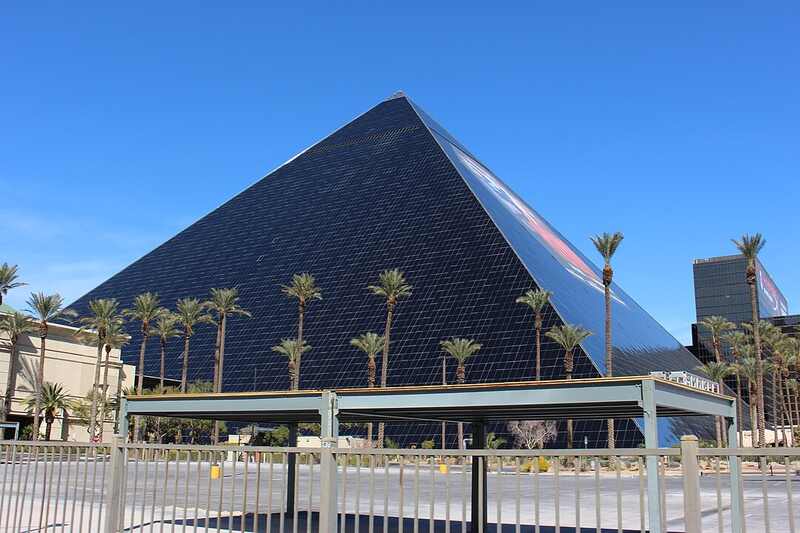Sign In
Volume and Surface Area of Pyramids
| | 13 Theory slides |
| | 9 Exercises - Grade E - A |
| | Each lesson is meant to take 1-2 classroom sessions |
Catch-Up and Review
Here are a few recommended readings before getting started with this lesson.
Types and Properties of Three-Dimensional Figures:
Geometric Measures of Three-Dimensional Figures:
The Potion Challenge
LaShay and Vincenzo step through the ancient, engraved doors of the Pyramidium House. As they enter, a guidebook enveloped in a mystical glow drifts toward them. It flips open to a page titled The Potion Challenge,
marking the beginning of their enthralling quest.
The book lays out a fascinating challenge: LaShay and Vincenzo are to craft a magical potion, transferring it from a prism-shaped container into two smaller pyramid-shaped vessels.

To escape the enigmatic confines of the Pyramidium House, they must unravel a series of enigmatic challenges, starting with this one. Help them answer the following questions to solve this great challenge.
Pyramid
A pyramid is a polyhedron that has a base, which can be any polygon, and faces that are triangular and meet at a vertex called the apex. The triangular faces are called lateral faces. The altitude of a pyramid is the perpendicular segment that connects the apex to the base, similar to the altitude of a triangle.

The length of the altitude is the height of the pyramid. If a pyramid has a regular polygon as its base and congruent, isosceles triangles as its lateral faces, it is called a regular pyramid. The altitude of each lateral face in a regular pyramid is also known as the slant height of the pyramid.

If the apex of the pyramid is over the center of its base, it is called a right pyramid. Otherwise, it is called an oblique pyramid.

Is It a Pyramid?
The applet shows various three-dimensional shapes. Identify if the given 3D shape is a pyramid.

Volume of a Pyramid
The volume of a pyramid is one third of the product of its base area and height.

The base area B is the area of the polygon opposite the vertex of the pyramid, and the height h is measured perpendicular to the base.
V=31Bh
The Secret Chamber's Pyramid

Hint
Find the area of the base using the formula for the area of a triangle. Then, use the formula for the volume of a pyramid to calculate its volume.
Solution

B=10.825, h=12
Multiply
Calculate quotient
The Puzzle of the Shifting Walls
After successfully solving the riddle of the Secret Chamber's Pyramid, LaShay and Vincenzo enter a room where the walls are constantly moving and reshaping the space. Amidst this changing environment, they notice several geometrically shaped vessels that are morphing in shape and size. One vessel, in the shape of a pentagonal pyramid, catches their attention.

The volume of the vessel, the side length of the base, and its apothem are known. However, the height of the vessel cannot be seen due to the shifting walls. LaShay and Vincenzo need to calculate the height of the vessel to stabilize the room. Help LaShay and Vincenzo solve it!
Hint
Calculate the perimeter p of the base of the vessel. Then, find the area of the base using the formula A=21a⋅p. Finally, substitute the area of the base of the vessel and its volume into the formula for the volume of a pyramid and solve for h.
Solution
a=5.5, p=40
Multiply
b1⋅a=ba
Calculate quotient
V=1100, B=110
LHS/110=RHS/110
Rearrange equation
LHS⋅3=RHS⋅3
Surface Area of a Pyramid
Consider a regular pyramid with an edge length s and a slant height ℓ.

The surface area SA of a regular pyramid can be calculated using the following formula.
SA=21pℓ+B
The Secret Code

Hint
Start by finding the perimeter and the base area of the pyramid. Then, substitute this information jointly with the slant height of the pyramid into the formula for the surface area of a pyramid to find the surface area of the inverted pyramid.
Solution

Substitute values
Multiply
b1⋅a=ba
Calculate quotient
Add terms
The Enchanted Garden Challenge

Hint
Start by finding the area and the perimeter of the base. Then, plug these values and the surface area into the formula for the surface area of a pyramid. Solve the obtained equation for the slant height ℓ.
Solution

Perimeter of the Base
Since the base is an equilateral triangle with a side length of 6 meters, multiply this side length by 3 to get the perimeter of the base.Area of the Base
The area of a triangle is calculated as half the product of its base and height.
c=6, b=3
Calculate power
LHS−9=RHS−9
Rearrange equation
LHS=RHS
Split into factors
a⋅b=a⋅b
Calculate root
a>0
b=6, h=33
Multiply
b1⋅a=ba
Calculate quotient
Calculating the Slant Height
The base area, the base perimeter, and surface area can now be substituted into the formula for the surface area of a pyramid. Then, the obtained equation can be solved for ℓ to find the slant height of the trellises.Substitute values
LHS−93=RHS−93
b1⋅a=ba
Calculate quotient
Rearrange equation
LHS/9=RHS/9
Practice Finding the Surface Area and Volume of Pyramids
The Celestial Observatory

Hint
Find the side length and the perimeter of the base. Then substitute these values and the surface area in the formula for the surface area of a pyramid and solve for the slant height. Finally, use the Pythagorean Theorem to find the pyramid's height.
Solution
The height and base area of the pyramid are required to calculate its volume. Here, only the surface area and base area are given. In that case, start by determining the side length of the base, the perimeter, the slant height, and finally the height of the pyramid. Then the volume of the pyramid can be determined.
Side Length of the Base
Since the base is a square, take the square root of the base area to find the side length s of the base.Perimeter of the Base
Now that the side length of the base is known multiply it by 4 to find its perimeter p.Slant Height of the Pyramid
The perimeter and area of the base of the pyramid are known, as well as its surface area. Plug in this information in the formula for the surface area of a pyramid and solve for the slant height ℓ.Substitute values
LHS−100=RHS−100
b1⋅a=ba
Calculate quotient
LHS/20=RHS/20
Rearrange equation
Height of the Pyramid
LaShay and Vincenzo can use the information gathered so far to calculate the height of the pyramid. Since it is a right pyramid, the vertex is located above the center of its base. This also means that the distance between the center and the midpoint of any side length of the base is equivalent to half the length of that side.
AC=19, BC=5
Calculate power
LHS−25=RHS−25
Rearrange equation
LHS=RHS
Split into factors
a⋅b=a⋅b
Calculate root
Volume of the Pyramid
Plug in the height of the pyramid and the area of its base into the formula for the volume of a pyramid to determine the volume of the Celestial Observatory.B=100, h=421
Multiply
b1⋅a=ba
Use a calculator
Round to nearest integer
The Apex of Discovery
After completing the last adventure of the Pyramidium House, LaShay and Vincenzo enter the heart of the structure. They recall their initial challenge of needing to pour a potion from a prism container into two smaller pyramid containers.

Using their newfound knowledge and the given dimensions, they can calculate whether the portion in the prism is enough to fill both pyramids.
Hint
Solution
B=4, h=6
Multiply
b1⋅a=ba
Calculate quotient
A glass lampshade has a hexagonal base with each side measuring 12 centimeters and a slant height of 17 centimeters.

Let's take a look at the diagram of the glass lampshade.
The lampshade is a hexagonal pyramid. Since the lampshade is open on the bottom, we need to determine the lateral area of this pyramid to figure out the amount of glass required to make it. We can use a formula that is similar to the surface area of a pyramid but without the area of the base to calculate the lateral area LA of the pyramid. LA=1/2pl In this case, the lampshade has a slant height of 17 centimeters and a base length of 12 centimeters. Since the base is a hexagon, we can multiply the side length by 6 to determine the perimeter of the base. Perimeter of the Base 6*12cm=72cm The perimeter of the base is 72 centimeters. Let's substitute the slant height of the pyramid and the perimeter of the base into the formula for the lateral area to find the amount of glass required to construct this lampshade.
The lateral area of the pyramid is 612 square centimeters, which means that the amount of glass required to construct this lampshade is 612 square centimeters.
Ignacio's dad is constructing a new art studio in their garden. To select an appropriate heater, he needs to calculate the British Thermal Units (BTUs) necessary for warming the studio.

Start by looking at the given diagram.
The building can be divided into the rectangular base and the pyramid ceiling. The rectangular base has a length and width of 30 feet and the height of 12 feet. We can calculate the volume of the rectangular base by multiplying these dimensions together. Volume of the Rectangular Base 30*30*12=10 800ft^3 The volume of the rectangular base is 10 800 cubic feet. Next, we can use the formula for the volume of a pyramid to determine the volume of the ceiling. We know that the ceiling has a square base with a side length of 30 feet, and a height of 5 feet. Let's plug in these values into the formula.
The volume of the ceiling is 1500 cubic feet. We can add the volume of the ceiling to the volume of the rectangular base to calculate the total volume of the building. Total Volume 10 800+ 1500 = 12 300ft^3 Since 2 BTUs are required for every cubic foot, we can multiply the total volume by 2. This will give us the size of the heating unit that Ignacio's father should purchase for the art studio. Size of the Heating Unit 2* 12 300=24 600BTUs
Determine the total surface area of the glass covering the Luxor Hotel in Las Vegas, a pyramid-shaped structure. The base of the hotel is a square, each side measuring 197 meters, and its height is 107 meters. Round the answer to the nearest tenth.
Let's create a diagram of the Luxor Hotel.
We can find the surface area of the glass covering the hotel by using the formula for the lateral area LA of a pyramid. LA=1/2pl However, we must first determine the slant height of the pyramid to apply this formula. Since the pyramid is a right pyramid, its vertex is located over the center of its base. In addition, the distance between the center and a side is half its side length, which is 1972=98.5 meters.
We can see that the slant height of the pyramid is the hypotenuse of the right triangle ABC. Since we know the measure of both legs of this triangle, we can use the Pythagorean Theorem to find the slant height of the pyramid.
The slant height of the pyramid is approximately 145.434693... meters. Now, since the base of the pyramid is a square, we can determine its perimeter by multiplying its side length by 4. Perimeter of the Base 4*197=788m Now that we know the perimeter of the base and the slant height of the pyramid, we can apply the formula for the lateral area to determine the total surface area of the glass covering the hotel.
Therefore, the total surface area of the glass is approximately 57 301.3 square meters.


